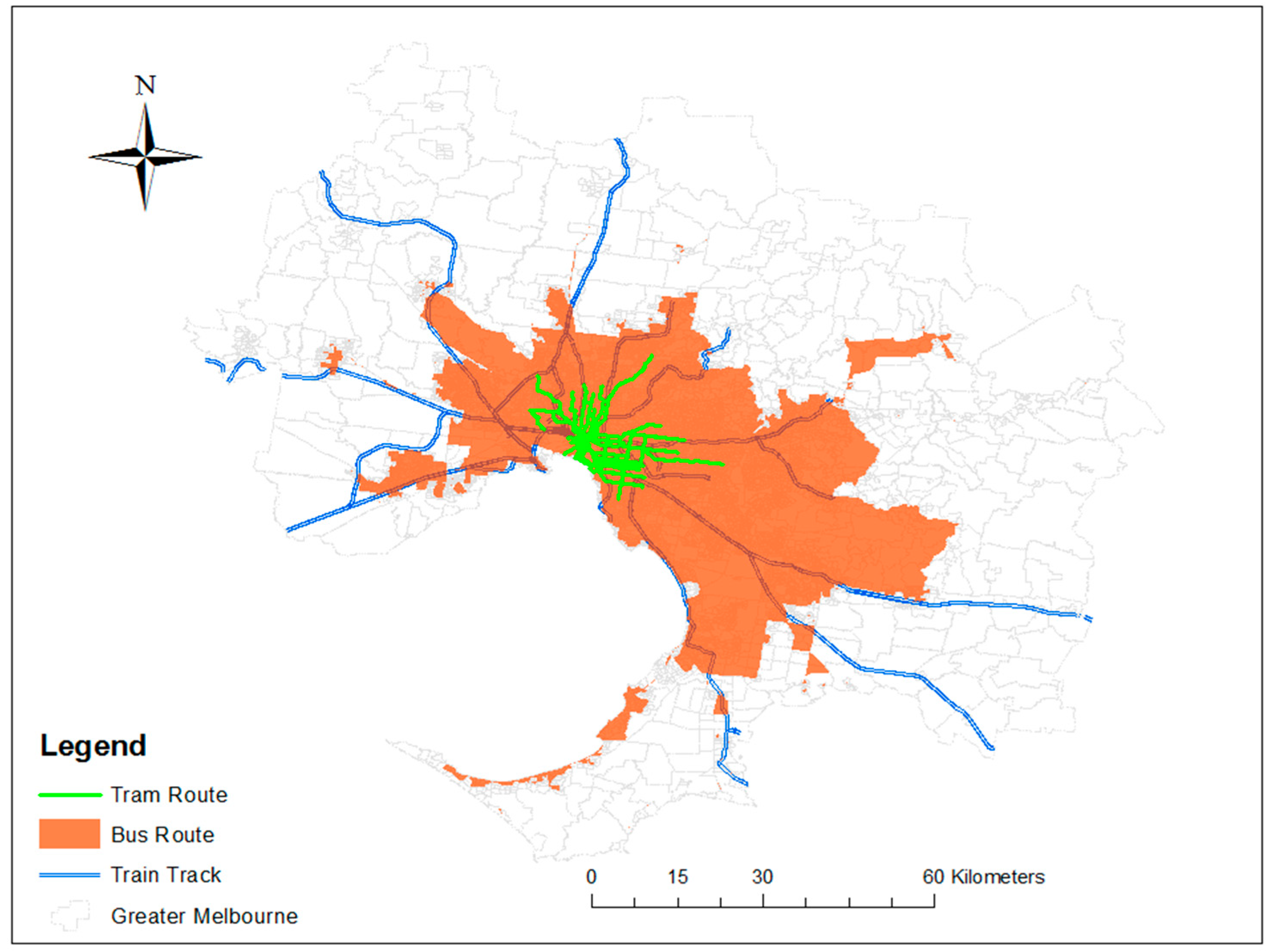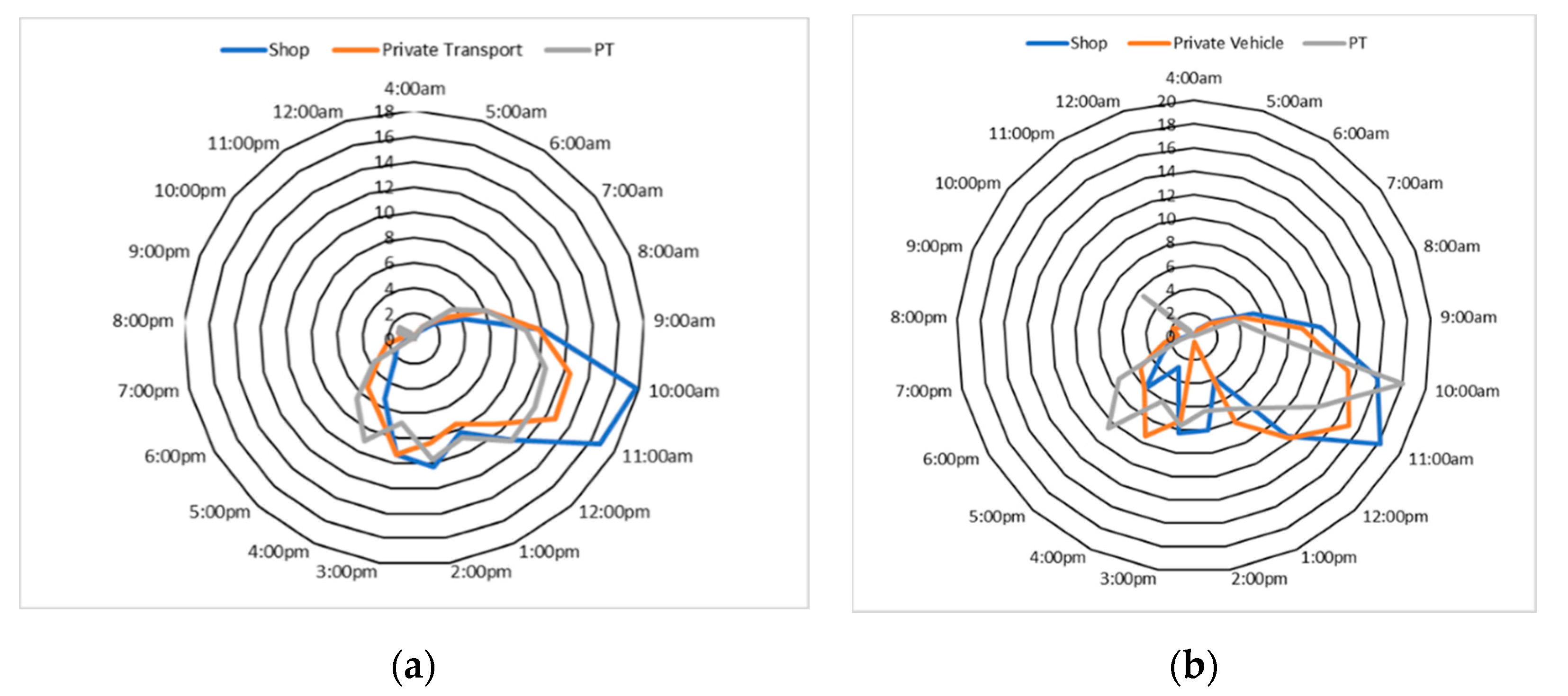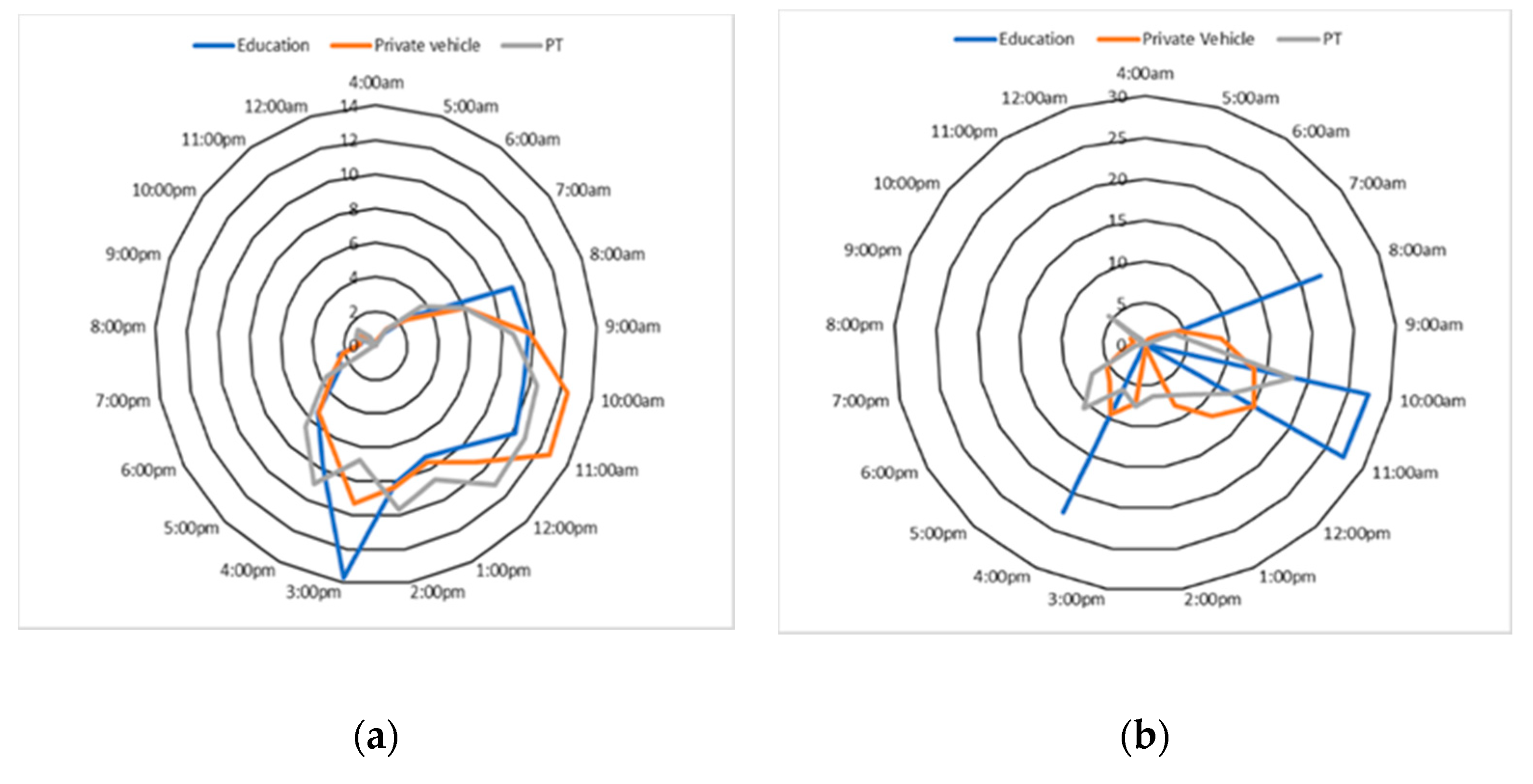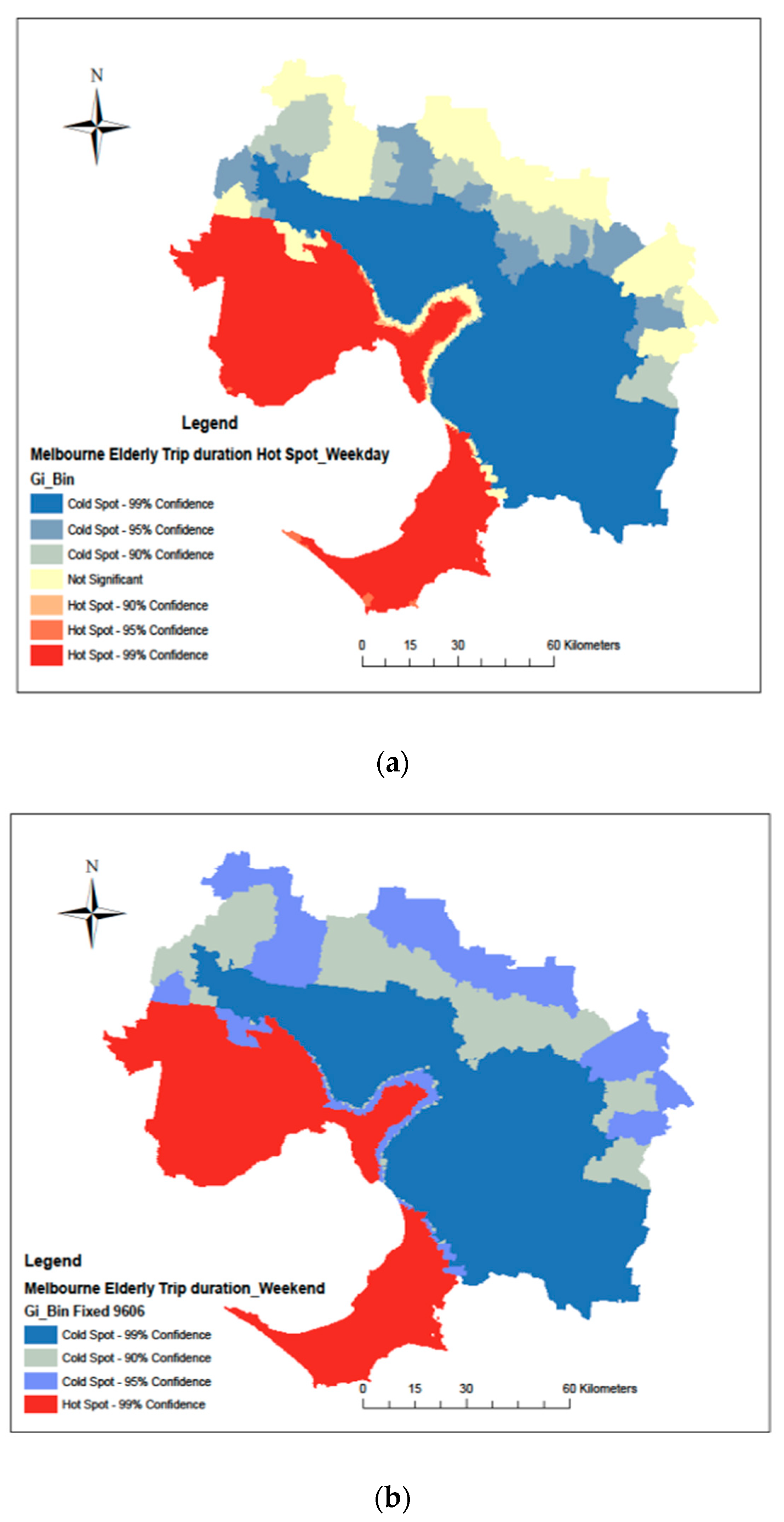Spatial and Temporal Distribution of Elderly Public Transport Mode Preference
Abstract
1. Introduction
- Is there any spatial dependency between elderly travel time duration and choice of transport mode?
- What times during the day are the elderly choosing PT over private transport?
- Do the trip hotspots vary during the weekdays and weekend?
2. Literature Review
3. Study Area and Data Description
3.1. Household Survey Data
3.2. Trip Characteristics
- Trip Purpose
- Trip time of the day
- Trip duration
3.3. Point of Interest (POI) and Public Transport (PT) Coverage
4. Methodology
4.1. Bivariate Pearson Correlation
4.2. Hotspot Analysis (Getis–Ord Gi* Statistic Method)
5. Results and Discussion
5.1. Bivariate Correlation Analysis Result
5.2. Temporal Analysis
5.3. Discussion
5.4. Spatial Analysis
6. Conclusions and Future Research
Author Contributions
Funding
Institutional Review Board Statement
Informed Consent Statement
Data Availability Statement
Acknowledgments
Conflicts of Interest
References
- United Nations, Department of Economic and Social Affairs, Population Division. World Population Ageing 2017-Highlights (ST/ESA/SER.A/397); United Nations, Department of Economic and Social Affairs, Population Division: New York, NY, USA, 2017. [Google Scholar]
- Meyer, M.D.; Miller, E.J. Urban Transportation Planning, 2nd ed.; McGraw Hill: New York, NY, USA, 2001. [Google Scholar]
- Shrestha, B.P.; Millonig, A.; Hounsell, N.B.; McDonald, M. Review of Public Transport Needs of Older People in European Context. J. Popul. Ageing 2017, 10, 343–361. [Google Scholar] [CrossRef]
- Acker, V.V.; Goodwin, P.; Witlox, F. Key research themes on travel behavior, lifestyle, and sustainable urban mobility. Int. J. Sustain. Transp. 2016, 10, 25–32. [Google Scholar] [CrossRef]
- Metz, D. Transport policy for an ageing population. Transp. Rev. 2003, 23, 375–386. [Google Scholar] [CrossRef]
- Lee, S.G.; Hickman, M. Trip purpose inference using automated fare collection data. Public Transp. 2014, 6, 1–20. [Google Scholar] [CrossRef]
- Alexander, L.; Jiang, S.; Murga, M.; González, M.C. Origin–destination trips by purpose and time of day inferred from mobile phone data. Transp. Res. Part C Emerg. Technol. 2015, 58, 240–250. [Google Scholar] [CrossRef]
- Daraio, C.; Diana, M.; Di Costa, F.; Leporelli, C.; Matteucci, G.; Nastasi, A. Efficiency and effectiveness in the urban public transport sector: A critical review with directions for future research. Eur. J. Oper. Res. 2016, 248, 1–20. [Google Scholar] [CrossRef]
- Higgs, G. A Literature Review of the Use of GIS-Based Measures of Access to Health Care Services. Heal. Serv. Outcomes Res. Methodol. 2004, 5, 119–139. [Google Scholar] [CrossRef]
- Fisher, R.; Lassa, J. Interactive, open source, travel time scenario modelling: Tools to facilitate participation in health service access analysis. Int. J. Health Geogr. 2017, 16, 13. [Google Scholar] [CrossRef]
- UNCHS. Indicators Programme: Monitoring Human Settlements: Urban Indicators Worksheet; Centre for Human Settlements, United Nations: New York, NY, USA, 1995; Volume 2. [Google Scholar]
- Scheiner, J. Social inequalities in travel behaviour: Trip distances in the context of residential self-selection and lifestyles. J. Transp. Geogr. 2010, 18, 679–690. [Google Scholar] [CrossRef]
- Wong, R.; Szeto, W.; Yang, L.; Li, Y.; Wong, S. Public transport policy measures for improving elderly mobility. Transp. Policy 2018, 63, 73–79. [Google Scholar] [CrossRef]
- Borst, H.C.; Vries, S.I.; Graham, J.M.A.; van Dongen, J.E.F.; Bakker, I.; Miedema, H.M.E. Influence of environmental street characteristics on walking route choice of elderly people. J. Environ. Psychol. 2009, 29, 477–484. [Google Scholar] [CrossRef]
- Pettersson, P.; Schmöcker, J.-D. Active ageing in developing countries?–trip generation and tour complexity of older people in Metro Manila. J. Transp. Geogr. 2010, 18, 613–623. [Google Scholar] [CrossRef]
- Truong, L.T.; Somenahalli, S.V.C. Exploring frequency of public transport use among older adults: A study in Adelaide, Australia. Travel Behav. Soc. 2015, 2, 148–155. [Google Scholar] [CrossRef]
- Adorno, G.; Fields, N.; Cronley, C.; Parekh, R.; Magruder, K. Ageing in a low-density urban city: Transportation mobility as a social equity issue. Ageing Soc. 2018, 38, 296–320. [Google Scholar] [CrossRef]
- Cui, J.; Loo, B.P.; Lin, N. Travel behaviour and mobility needs of older adults in an ageing and car-dependent society. Int. J. Urban Sci. 2017, 21, 109–128. [Google Scholar] [CrossRef]
- Fatima, K.; Moridpour, S.; De Gruyter, C.; Saghapour, T. Elderly Sustainable Mobility: Scientific Paper Review. Sustainability 2020, 12, 7319. [Google Scholar] [CrossRef]
- Zhou, Y.; Yuan, Q.; Yang, C. Transport for the Elderly: Activity Patterns, Mode Choices, and Spatiotemporal Constraints. Sustainability 2020, 12, 10024. [Google Scholar] [CrossRef]
- Chaisomboon, M.; Jomnonkwao, S.; Ratanavaraha, V. Elderly Users’ Satisfaction with Public Transport in Thailand Using Different Importance Performance Analysis Approaches. Sustainability 2020, 12, 9066. [Google Scholar] [CrossRef]
- McIntosh, G.; Phillips, J. Caring for the Elderly’—An Overview of Aged Care Support and Services in Australia. 2003. Available online: https://www.aph.gov.au/About_Parliament/Parliamentary_Departments/Parliamentary_Library/Publications_Archive/archive/agedcare (accessed on 16 March 2021).
- Martin, P. Individual and social resources predicting well-being and functioning in the later years: Conceptual models, research and practice. Age Int. 2002, 27, 3–29. [Google Scholar] [CrossRef]
- Phelan, E.A.; Anderson, L.A.; Lacroix, A.Z.; Larson, E.B. Older adults’ views of “successful aging”—How do they compare with researchers’ definitions? J. Am. Geriatr. Soc. 2004, 52, 211–216. [Google Scholar] [CrossRef]
- Vaillant, G.E. Aging Well: Surprising Guideposts to a Happier Life from the Landmark Study of Adult Development; Little, Brown: Boston, MA, USA, 2008. [Google Scholar]
- Collia, D.V.; Sharp, J.; Giesbrecht, L. The 2001 National Household Travel Survey: A look into the travel patterns of older Americans. J. Saf. Res. 2003, 34, 461–470. [Google Scholar] [CrossRef] [PubMed]
- Hu, X.; Wang, J.; Wang, L. Understanding the Travel Behavior of Elderly People in the Developing Country: A Case Study of Changchun, China. Procedia-Soc. Behav. Sci. 2013, 96, 873–880. [Google Scholar] [CrossRef]
- Hwang, H.L.; Wilson, D.W.; Reuscher, T.; Yang, J.; Taylor, R.D.; Chin, S.M. Travel Patterns and Characteristics of Elderly Subpopulation in New York State; Oak Ridge National Lab, ORNL: Oak Ridge, TN, USA, 2015. [Google Scholar]
- Szeto, W.; Yang, L.; Wong, R.; Li, Y.; Wong, S. Spatio-temporal travel characteristics of the elderly in an ageing society. Travel Behav. Soc. 2017, 9, 10–20. [Google Scholar] [CrossRef]
- Alsnih, R.; Hensher, D.A. The mobility and accessibility expectations of seniors in an aging population. Transp. Res. Part A Policy Pr. 2003, 37, 903–916. [Google Scholar] [CrossRef]
- Banister, D.; Bowling, A. Quality of life for the elderly: The transport dimension. Transp. Policy 2004, 11, 105–115. [Google Scholar] [CrossRef]
- Burnett, P.; Lucas, S. Talking, walking, riding and driving: The mobilities of older adults. J. Transp. Geogr. 2010, 18, 596–602. [Google Scholar] [CrossRef]
- Hjorthol, R.J.; Levin, L.; Sirén, A. Mobility in different generations of older persons: The development of daily travel in different cohorts in Denmark, Norway and Sweden. J. Transp. Geogr. 2010, 18, 624–633. [Google Scholar] [CrossRef]
- Musselwhite, C.; Haddad, H. Mobility, accessibility and quality of later life. Qual. Ageing Older Adults 2010, 11, 25–37. [Google Scholar] [CrossRef]
- Merlin, L.A. A portrait of accessibility change for four US metropolitan areas. J. Transp. Land Use 2016, 10, 309–336. [Google Scholar] [CrossRef][Green Version]
- Handy, S.L.; Niemeier, D.A. Measuring Accessibility: An Exploration of Issues and Alternatives. Environ. Plan A Econ. Space 1997, 29, 1175–1194. [Google Scholar] [CrossRef]
- Yildirimoglu, M.; Geroliminis, N. Experienced travel time prediction for congested freeways. Transp. Res. Part B Methodol. 2013, 53, 45–63. [Google Scholar] [CrossRef]
- Tao, S.; Rohde, D.; Corcoran, J. Examining the spatial–temporal dynamics of bus passenger travel behaviour using smart card data and the flow-map. J. Transp. Geogr. 2014, 41, 21–36. [Google Scholar] [CrossRef]
- Fransen, K.; Farber, S.; Deruyter, G.; De Maeyer, P. A spatio-temporal accessibility measure for modelling activity participation in discretionary activities. Travel Behav. Soc. 2018, 10, 10–20. [Google Scholar] [CrossRef]
- Kamruzzaman, M.; De Vos, J.; Currie, G.; Giles-Corti, B.; Turrell, G. Spatial biases in residential mobility: Implications for travel behaviour research. Travel Behav. Soc. 2020, 18, 15–28. [Google Scholar] [CrossRef]
- Habib, K.N. An investigation on mode choice and travel distance demand of older people in the National Capital Region (NCR) of Canada: Application of a utility theoretic joint econometric model. Transportation 2015, 42, 143–161. [Google Scholar] [CrossRef]
- Moniruzzaman, M.; Paez, A.; Habib, K.M.N.; Morency, C. Mode use and trip length of seniors in Montreal. J. Transp. Geogr. 2013, 30, 89–99. [Google Scholar] [CrossRef]
- Morency, C.; Paez, A.; Roorda, M.J.; Mercado, R.; Farber, S. Distance traveled in three Canadian cities: Spatial analysis from the perspective of vulnerable population segments. J. Transp. Geogr. 2011, 19, 39–50. [Google Scholar] [CrossRef]
- Schmöcker, J.-D.; Quddus, M.A.; Noland, R.B.; Bell, M.G. Mode choice of older and disabled people: A case study of shopping trips in London. J. Transp. Geogr. 2008, 16, 257–267. [Google Scholar] [CrossRef]
- Mercado, R.G.; Páez, A.; Scott, D.M.; Newbold, K.B.; Kanaroglou, P. Transportation in aging societies: An international comparison and implications for Canada. Open Transp. J. 2007, 1, 1–13. [Google Scholar] [CrossRef]
- Paez, A.; Scott, D.; Potoglou, D.; Kanaroglou, P.; Newbold, K.B. Elderly mobility: Demographic and spatial analysis of trip making in the Hamilton CMA, Canada. Urban Stud. 2007, 44, 123–146. [Google Scholar] [CrossRef]
- Sylvia, Y.H.; Yannie, H.Y.; Cheung, S.T. Travel mobility and social participation among older people in a transit metropolis: A socio-spatial-temporal perspective. Transp. Res. Part A 2018, 118, 608–626. [Google Scholar]
- He, W.; Goodkind, D.; Kowal, P. An Aging World: 2015, International Population Reports; U.S. Government Publishing Office: Washington, DC, USA, 2016; Volume 16, p. 95. [Google Scholar]
- Kim, S. Transportation Alternatives of the Elderly after Driving Cessation. Transp. Res. Rec. J. Transp. Res. Board 2011, 2265, 170–176. [Google Scholar] [CrossRef]
- Böcker, L.; Thorsson, S. Integrated Weather Effects on Cycling Shares, Frequencies, and Durations in Rotterdam, the Netherlands. Weather. Clim. Soc. 2014, 6, 468–481. [Google Scholar] [CrossRef]
- Liu, C.; Bardaka, E.; Palakurthy, R.; Tung, L.-W. Analysis of travel characteristics and access mode choice of elderly urban rail riders in Denver, Colorado. Travel Behav. Soc. 2020, 19, 194–206. [Google Scholar] [CrossRef]
- Cheng, L.; Chen, X.; Yanga, S.; Caob, Z.; Vos, J.D.; Witlox, F. Active travel for active ageing in China: The role of built environment. J. Transp. Geogr. 2019, 76, 142–152. [Google Scholar] [CrossRef]
- Yang, S.; Fan, Y.; Deng, W.; Cheng, L. Do built environment effects on travel behavior differ between household members? A case study of Nanjing, China. Transp. Policy 2019, 81, 360–370. [Google Scholar] [CrossRef]
- Mifsud, D.; Attard, M.; Ison, S. To drive or to use the bus? An exploratory study of older people in Malta. J. Transp. Geogr. 2017, 64, 23–32. [Google Scholar] [CrossRef]
- Ewing, R.; Cervero, R. Travel and the built environment: A meta-analysis. J. Am. Plan. Assoc. 2010, 76, 265–294. [Google Scholar] [CrossRef]
- Kim, S.; Ulfarsson, G.F. Travel Mode Choice of the Elderly: Effects of Personal, Household, Neighborhood, and Trip Characteristics. Transp. Res. Rec. J. Transp. Res. Board 2004, 1894, 117–126. [Google Scholar] [CrossRef]
- Schwanen, T.; Dijst, M.; Dieleman, F.M. Leisure trips of senior citizens: Determinants of modal choice. J. Econ. Hum. Geogr. 2001, 92, 347–360. [Google Scholar] [CrossRef]
- Somenahalli, S.V.C.; Taylor, M.A.P. Ageing and transport: Mobility issues-a case study for Adelaide. In Proceedings of the 3rd State of Australian Cities National Conference, Adelaide, Australia, 28–30 November 2007. [Google Scholar]
- Somenahalli, S.; Hayashi, Y.; Taylor, M. Accessible transportation and mobility issues of elderly—How does Australia compare with Japan? J. Sustain. Urban. Plan. Prog. 2016, 1, 31–43. [Google Scholar] [CrossRef]
- Lin, T.G.; Xia, J.C.; Robinson, T.P.; Goulias, G.K.; Church, L.R.; Olaru, D.; Tapin, J.; Han, R. Spatial analysis of access to and accessibility surrounding train stations: A case study of accessibility for the elderly in Perth, Western Australia. J. Transp. Geogr. 2014, 39, 111–120. [Google Scholar] [CrossRef]
- Shao, F.; Sui, Y.; Yu, X.; Sun, R. Spatio-temporal travel patterns of elderly people–A comparative study based on buses usage in Qingdao, China. J. Transp. Geogr. 2019, 76, 178–190. [Google Scholar] [CrossRef]
- Australian Bureau of Statistics (ABS). Australian Historical Population Statistics, 2014; ABS Cat. No. 3105.0.65.001; ABS: Canberra, Australia, 2014. [Google Scholar]
- Australian Bureau of Statistics (ABS). ABS Census of Population and Housing. Available online: https://quickstats.censusdata.abs.gov.au/census_services/getproduct/census/2016/quickstat/2?opendocument (accessed on 16 March 2021).
- Robert, S.; Schönfelder, S.; Susan, H.; Kay, W.A. Structures of Leisure Travel: Temporal and Spatial Variability. Transp. Rev. 2004, 24, 219–237. [Google Scholar]
- Yusak, O.S.; Ryuichi, K. Analysis of Day-to-Day Variability in an Individual’s Action Space: Exploration of 6-Week Mobidrive Travel Diary Data. Transp. Res. Rec. J. 2005, 1902, 124–133. [Google Scholar] [CrossRef]
- Victorian Integrated Survey of Travel and Activity (VISTA); Department of Transport: Melbourne, Australia, 2016. Available online: https://transport.vic.gov.au/about/data-and-research/vista (accessed on 16 March 2021).
- Australian Urban Research Infrastructure Network (AURIN). Available online: https://aurin.org.au/ (accessed on 16 March 2021).
- Chu, K.; Chapleau, R. Augmenting transit trip characterisation and travel behaviour Comprehension. Transp. Res. Board 2010, 2183, 29–40. [Google Scholar] [CrossRef]
- Trépanier, M.; Tranchant, N.; Chapleau, R. Individual trip destination estimation in a transit smart card automated fare collection system. J. Intell. Transp. Syst. 2007, 11, 1–14. [Google Scholar] [CrossRef]
- Agard, B.; Morency, C.; Trépanier, M. Mining smart card data from an urban transit network. In Encyclopedia of Data Warehouse and Mining (Second edition). Information Science Reference; Information Science, IGI Global: Hershey, PA, USA, 2009; pp. 1292–1302. [Google Scholar]
- Ding, L.; Zhang, N. A Travel Mode Choice Model Using Individual Grouping Based on Cluster Analysis. Procedia Eng. 2016, 137, 786–795. [Google Scholar] [CrossRef]
- Sánchez-Martín, J.-M.; Rengifo-Gallego, J.-I.; Blas-Morato, R. Hot Spot Analysis versus Cluster and Outlier Analysis: An Enquiry into the Grouping of Rural Accommodation in Extremadura (Spain). ISPRS Int. J. Geo-Inf. 2019, 8, 176. [Google Scholar] [CrossRef]
- Zhao, P.; Bucher, D.; Martin, H.; Raubal, M. A Clustering-Based Framework for Understanding Individuals’ Travel Mode Choice Behavior. In Geospatial Technologies for Local and Regional Development, Proceedings of the International Conference on Geographic Information Science AGILE 2019, Limassol, Cyprus, 17–20 June 2019; Lecture Notes in Geoinformation and Cartography; Kyriakidis, P., Hadjimitsis, D., Skarlatos, D., Mansourian, A., Eds.; Springer: Cham, Germany, 2020; pp. 77–94. [Google Scholar]
- ArcGISPro. Available online: https://pro.arcgis.com/en/pro-app/tool-reference/spatial-statistics/h-how-hot-spot-analysis-getis-ord-gi-spatial-stati.htm (accessed on 16 March 2021).
- Neutens, T.; Delafontain, M.; Scott, D.M.; Maeyer, D.P. An analysis of day-to-day variations in individual space–time accessibility. J. Transp. Geogr. 2012, 23, 81–91. [Google Scholar] [CrossRef]
- Neutens, T. Accessibility, equity and health care: Review and research directions for transport geographers. J. Transp. Geogr. 2015, 43, 14–27. [Google Scholar] [CrossRef]
- A Policy Brief from the Policy Learning Platform on Low-Carbon Economy. June 2018. Available online: https://www.interregeurope.eu/fileadmin/user_upload/plp_uploads/policy_briefs/2018-06-27_Policy_Brief_Demand_Responsive_Transport.pdf (accessed on 16 March 2021).
- Jittrapirom, P.; van Neerven, W.; Martens, K.; Trampe, D.; Meurs, H. The Dutch elderly’s preferences toward a smart demand-responsive transport service. Res. Transp. Bus. Manag. 2019, 30, 100383. [Google Scholar] [CrossRef]
- Lakatos, A.; Tóth, J.; Mándoki, P. Demand Responsive Transport Service of ‘Dead-End Villages’ in Interurban Traffic. Sustainability 2020, 12, 3820. [Google Scholar] [CrossRef]







| POIs | Statistic Description | Trip Duration | Time of the Day | Trip Duration | Time of the Day |
|---|---|---|---|---|---|
| Weekdays | Weekends | ||||
| Shopping Centres | Pearson correlation (r) | 0.631 | 0.531 | 0.661 | 0.544 |
| Sig (2-tailed) | 0.000 | 0.000 | 0.000 | 0.000 | |
| Education Centres | Pearson correlation (r) | −0.120 | −0.231 | −0.129 | −0.131 |
| Sig (2-tailed) | 0.000 | 0.002 | 0.000 | 0.002 | |
| Recreation Centres | Pearson correlation (r) | −0.120 | −0.128 | −0.114 | −0.128 |
| Sig (2-tailed) | 0.000 | 0.000 | 0.000 | 0.000 | |
| Day | POIs | Time Group * | Public Transport (%) | Private Transport (%) |
|---|---|---|---|---|
| Weekday | Shopping | 1 | 6.0 | 85.0 |
| 2 | 2.0 | 90.0 | ||
| 3 | 5.0 | 91.0 | ||
| 4 | 2.0 | 97.0 | ||
| Education | 1 | 1.0 | 85.0 | |
| 2 | 1.0 | 87.0 | ||
| 3 | 2.0 | 95.0 | ||
| 4 | 2.0 | 97.0 | ||
| Recreation | 1 | <1.0 | 30.0 | |
| 2 | 1.0 | 50.0 | ||
| 3 | 1.0 | 90.0 | ||
| 4 | 1.0 | 93.0 | ||
| Weekend | Shopping | 1 | 4.0 | 94.0 |
| 2 | 1.0 | 98.0 | ||
| 3 | 2.0 | 95.0 | ||
| 4 | <1.0 | 93.0 | ||
| Education | 1 | <1.0 | 92.0 | |
| 2 | <1.0 | 93.0 | ||
| 3 | <1.0 | 96.0 | ||
| 4 | <1.0 | 96.0 | ||
| Recreation | 1 | <1.0 | 87.0 | |
| 2 | <1.0 | 94.0 | ||
| 3 | <1.0 | 93.0 | ||
| 4 | <1.0 | 96.0 |
| Days | Gender | Private Mode | Public Mode |
|---|---|---|---|
| Weekdays | Female | 1845 | 166 |
| Male | 1863 | 120 | |
| Weekend | Female | 563 | 38 |
| Male | 619 | 43 |
Publisher’s Note: MDPI stays neutral with regard to jurisdictional claims in published maps and institutional affiliations. |
© 2021 by the authors. Licensee MDPI, Basel, Switzerland. This article is an open access article distributed under the terms and conditions of the Creative Commons Attribution (CC BY) license (https://creativecommons.org/licenses/by/4.0/).
Share and Cite
Fatima, K.; Moridpour, S.; Saghapour, T. Spatial and Temporal Distribution of Elderly Public Transport Mode Preference. Sustainability 2021, 13, 4752. https://doi.org/10.3390/su13094752
Fatima K, Moridpour S, Saghapour T. Spatial and Temporal Distribution of Elderly Public Transport Mode Preference. Sustainability. 2021; 13(9):4752. https://doi.org/10.3390/su13094752
Chicago/Turabian StyleFatima, Kaniz, Sara Moridpour, and Tayebeh Saghapour. 2021. "Spatial and Temporal Distribution of Elderly Public Transport Mode Preference" Sustainability 13, no. 9: 4752. https://doi.org/10.3390/su13094752
APA StyleFatima, K., Moridpour, S., & Saghapour, T. (2021). Spatial and Temporal Distribution of Elderly Public Transport Mode Preference. Sustainability, 13(9), 4752. https://doi.org/10.3390/su13094752







